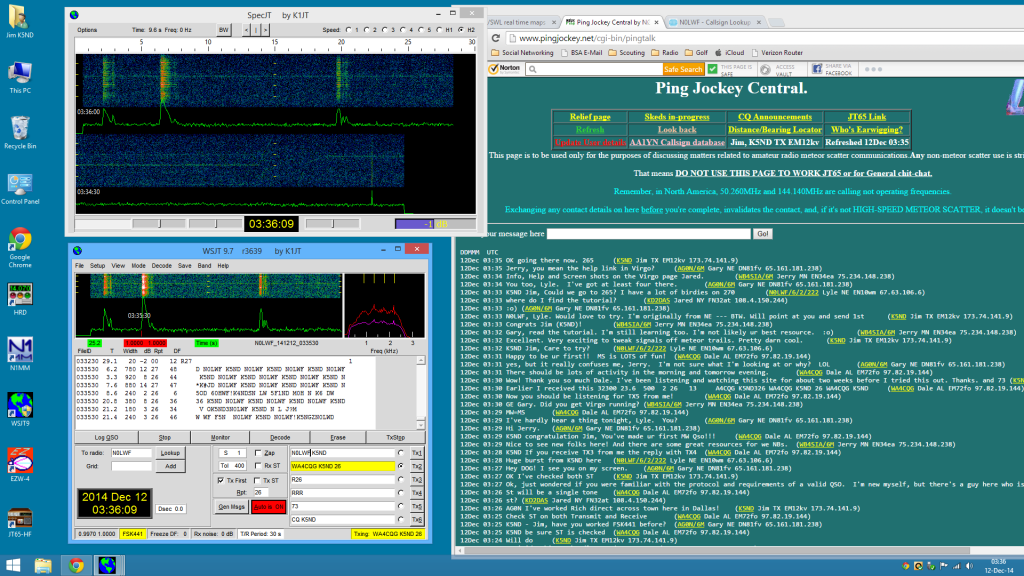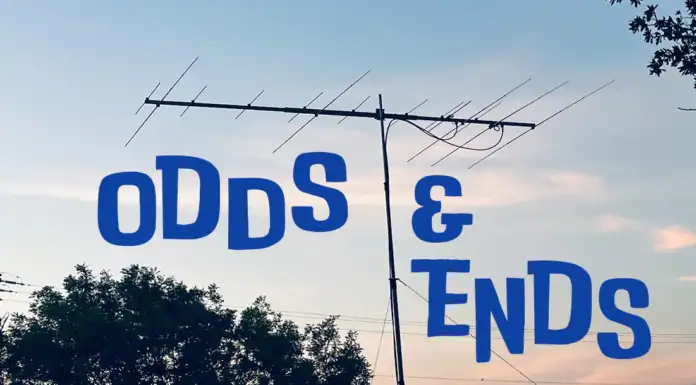I just had the experience of communicating over 600 miles using the ionized trails from meteors to bounce my signal to its destination. It’s a good time to do this as the Geminids meteor shower is underway and is expected to peak this weekend. But what a fun way to extend the range of six meter VHF signals when little else is available.
Meter Scatter Insight
So what is meteor scatter? As meteors enter the earth’s atmosphere, which happens 24/7, they ionize the E layer of the ionosphere. This allows radio signals to be refracted back to earth and hopefully onto someone’s antenna who is listening for you. The signals can last from seconds to microseconds. So it requires some special techniques to facilitate the communication.
The current technique uses Joe Taylor’s WSJT suite of software and FSK441 modulation. The FSK441 technique sends rapid fire digital signals over and over again during the course of a 30 second transmit window. The following 30 second window is when the other station will send their message back to you. There is a specific protocol for messages that you can find at FSK441 Meteor Scatter Procedures for IARU Region 2. There is also a required sequence that results in a confirmed contact.
While some meteor scatter contacts can no doubt happen on a random CQ basis, it makes for a far less frustrating and silent experience if you use Ping Jockey Central to coordinate transmit and receive frequency and sequence. You’ll also get some advice and assistance along the way.
As with nearly everything that I take up, I did a great deal of research on this mode. I found sound insight in the ARRL Operating Manual and a number of great QST articles from their archive. Check out Joe Taylor’s WSJT: New Software for VHF Meteor-Scatter Communication in the December 2001 QST issue. I also found historical background and deep physics explanations in Walter Bain’s VHF Propagation by Meteor-Trail Ionization in the May 1974 QST issue. Online I found OZ1RH’s article Working DX on a Dead 50 MHz Band using Meteor Scatter very helpful.
K5ND On the Air
Given all that research, I began to pull my station together and test out the WSJT FSK441 mode. You’ll recall that I’ve put up a Stressed Moxon on a pushup mast with Yaesu G-45oA rotator. Those were big keys to providing some gain and directivity. Connecting WSJT was very straightforward with the existing RTTY and other digital modes in my shack. Then I connected with Ping Jockey Central and started to do some listening.
Early on I was tinkering around with the set up for FSK441 and decided to push the transmit button. All things worked and I was considering my next move when a signal popped up on the P3 panadapter and then on the WSJT readout. It was KB7IJ, Rich, located about 14 miles south of me. That proved very helpful in validating my message set up and for me to get a good look at what the signal was actually sending. It also surprised Rich and me.
I continued to listen and monitor Ping Jockey as well as point the antenna toward the station that was transmitting, often times they were pointed at KB7IJ or other stations relatively close by. It was interesting to pick up bursts of their transmissions.
Last night I resolved to reach out on Ping Jockey and attempt to get something going. WA4CQG, Dale, in Auburn, AL agreed to send some signals back and forth. After the first few rounds we had exchanged call signs but couldn’g get the reports confirmed. At that point, Dale suggested that we go to single tone mode in FSK441 and that did the trick. Up until that point, I’d never even spotted the single tone check boxes. Big learning experience, but what a blast.
Right after that N0LWF, Lyle in Nebraska, asked for a QSO and we made that work. Also relying on single tone at the last of the QSO. I ended the evening with a similar QSO with N0KK, Kirk in Minnesota. Everyone on Ping Jockey was quite helpful in coaching me through these first QSOs and celebrating my success. It’s a nice community of ham radio operators.
Above you can see a screen shot of my computer during one of the QSOs. Click on the image for a larger version. It shows some of the meteor bursts on the WSJT traces, the decoded messages, and the all important connection to the Ping Jockey chat room.
This is yet another of my ham radio adventures. I recommend you give it a try.








Well Done Jim. Absolutely tickled that I could help out with that mind boggling first ever FSK441 QSO, so it was only cross town, have to start somewhere !
Hi Rich,
Thanks. What I appreciated was seeing the full FSK441 signal. As a result I gained a much better understanding of what was actually taking place. That’s been a big help as I try to decode bits and pieces in a real MS contact. Glad that I could wake you up as well!
73 and 55, Jim
[…] He reported the power was just fine. Hmmm, does that mean my power measuring gear is off? I had also sent along an Icom CR-293 high stability oscillator, which he installed. He also calibrated the output frequency. That should help with meteor scatter schedules. […]
[…] Meteor Scatter — A Burst of Excitement […]
[…] my longest contact, ZL1RS, as well as a few firsts including Transequatorial Propagation and Meteor Scatter. Here’s the […]
[…] Meteor Scatter — A Burst of Excitement – K5NDDec 12, 2014 … It’s a good time to do this as the Geminids meteor shower is underway and is expected to … It’s a nice community of ham radio operators. […]
[…] first meteor scatter contacts were using FSK441 and were quite a blast. See my article “Meteor Scatter — A Burst of Excitement” from 2014. So I have used and like the […]